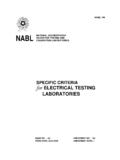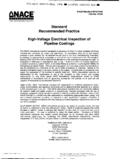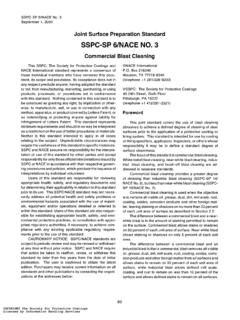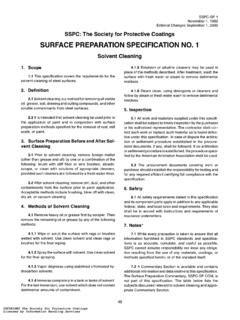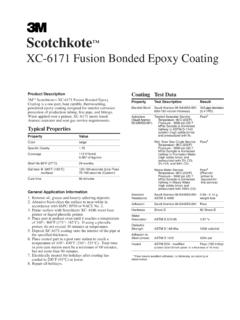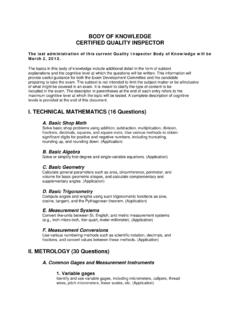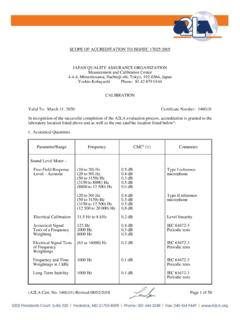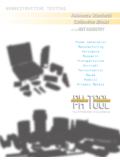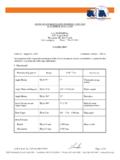Transcription of Measurement of Dry Coating Thickness with …
1 SSPC-PA 2 Measurement of Dry Coating Thickness with magnetic Gages The Society for Protective Coatings SSPC Publication No. 97-02 ISBN 1-889060-07-0 COPYRIGHT Steel Structures Painting CouncilLicensed by Information Handling ServicesCOPYRIGHT Steel Structures Painting CouncilLicensed by Information Handling ServicesDISCLAIMER This standard has been developed in accordance with volun- tary consensus procedures by SSPC Advisory Committees and is believed to represent good current practice. All SSPC specifi- cations, guides and recommendations are monitored and revised as practices improve, and suggestions for revision are welcome.
2 Other methods, materials, and specifications may be equally effective or superior. SSPC is not responsible for the application, interpretation, or administration of its specifications, guides and recommendations. Moreover, SSPC does not issue interpreta- tions of its specifications, guides or recommendations; and no person is authorized to issue an interpretation of an SSPC specification, guide or recommendation on behalf of SSPC. SSPC specifically disclaims responsibilityfor the use or misuse of its specifications, guides and recommendations.
3 The supplying of details about patented formulations, treatments, or processes is not to be regarded as conveying any right or permitting the user of this guide to use or sell any patented invention. When it is known that the subject matter of the text is covered by patent, such patents are reflected in the text. Copyright 1997 by SSPC The Society for Protective Coatings (fomlerly Steel Structures Painting Council) 40 24th St., 6th Floor Pittsburgh, PA 15222 All rights reserved This document or any part thereof may not be reproduced in any form without the written permission of the publisher.
4 Printed in COPYRIGHT Steel Structures Painting CouncilLicensed by Information Handling ServicesCOPYRIGHT Steel Structures Painting CouncilLicensed by Information Handling ServicesSSPC-PA 2 June 1,1996 SSPC PAINT APPLICATION STANDARD NO. 2 Measurement of Dry Coating Thickness with magnetic Gages 1. Scope GENERAL: This standard describes the procedures to measure the Thickness of a dry film of a nonmagnetic Coating applied on a magnetic substrate using commercially available magnetic gages. These procedures are intended to supplement manufacturers instructions for the manual operation of the gages and are not intended to replace them.
5 The procedures for calibration and Measurement are described for two types of gages: pull-off gages (Type 1) and constant pressure probe gages (Type 2). The standard defines a procedure to determine if the film Thickness over an extended area conforms to the minimum and the maximum levels specified. 2. Description and Use DEFINITIONS: gage Reading: A single reading at one point. Spot Measurement : The average of at least three gage readings made within a inch (4 cm) diameter circle. DESCRIPTION OF GAGES: gage Types: The gage type is determined by the specific magnetic properties employed in measuring the thick- ness and is not determined by the mode of data readout.
6 E. digital or analog. This standard does not cover gages that measure the effect of eddy currents produced in the substrate. Type l-Pull-Off Gages: In pull-off gages, a per- manent magnet is brought into direct contact with the coated surface and a calibrated scale measures the force necessary to pull the magnet from the surface. Less force is required to remove the magnet from a thick Coating . The scale is nonlinear. Type 1 A - A magnet is attached to one end of a pivoting balance arm. This assembly is connected to a calibrated helical spring.
7 By rotating a dial, the spring increases the force on the magnet and pulls it from the surface. The Type 1 A gages are commonly called banana gages. Type 1 B - A magnet is mounted directly or indirectly to a coil spring. The spring acts perpendicularly to the surface to pull off the magnet. The Type 1 B gages are commonly called pencil gages. Type 2-Constant Pressure Probe Gages: A con- stant pressure probe gage uses a probe which exerts a constant pressure on the coated surface during the entire measuring operation.
8 Electronic circuitry is used to convert a reference signal into Coating Thickness . (See .) USE OF STANDARD: This document contains the following: Calibration, verification and Measurement procedures (Section 4). Required number of measurements for conformance to a Thickness specification (Section 5). Notes on gage principles and various factors affecting Thickness Measurement (Section 8). A numerical example of Thickness Measurement over an extended area (Appendix 1). A numerical example of verification of the calibration of Type 2 gages using plastic shims (Appendix 2).
9 3. Reference Standards The documents and standards referenced in this stan- dard are listed in Section and form a part of this standard. The latest issue, revision or amendment of the refer- enced documents in effect on the date of invitation to bid shall govern unless otherwise specified. If there is a conflict between the requirements of any of the cited documents and this standard, the requirements of this standard shall prevail. NATIONAL INSTITUTE OF STANDARDS AND TECH- NOLOGY (N1ST)STANDARD REFERENCE MATERIALS.
10 (See Section 5.) 4. Calibration, Verification and Measurement Procedures GENERAL Access to Bare Substrate: All gages are affected to some degree by substrate conditions such as roughness, shape, Thickness and composition. To correct for this effect, access to the uncoated substrate is recommended. Another option is to use separate uncoated reference panels with similar rough- ness, shape, Thickness and composition. (See Sections to ) These would be used as the bare substrate in the proce- dures of Sections and Reference panels shall be of sufficient size to preclude edge effects.

